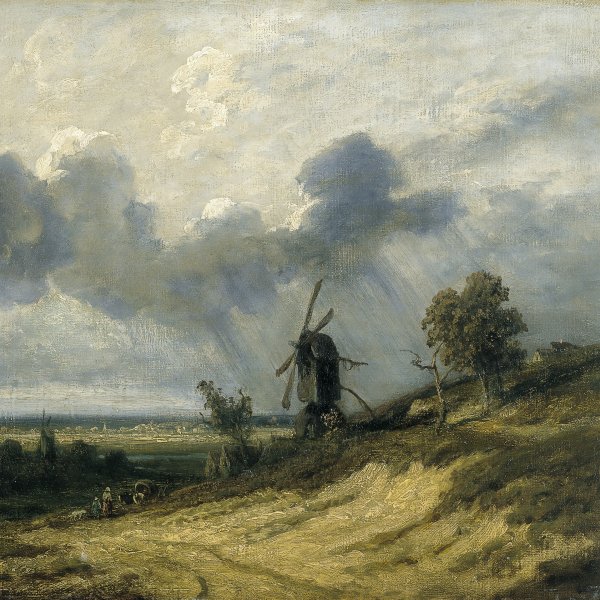Georges Michel
París, 1763-1843
Born into a humble family, Georges Michel became the protégé of the landowner M. De Chalue, who entrusted him to a parish priest from the vicinity of Saint Denis. Towards 1775 he was apprenticed to the painter Leduc. Later, he worked in the service of different members of the nobility, with whom he travelled to Normandy, Switzerland and Germany. Already in the 1780s, Michel copied some Dutch 17th-century paintings, and towards 1790 he befriended the painter Lazare Bruandet, with whom he made his first trips to paint in the suburbs of Paris, which became the main subject of his oeuvre.
In 1791 Michel took part for the first time in the Paris Salon, where he exhibited his work again continuously until 1814 without obtaining any acknowledgement. Until 1808, approximately, he collaborated with other French artists of the time, such as Jean-Louis Demarne and Jacques-François Swebach, both painters of popular landscapes and genre scenes. He also restored works for private collectors and towards 1800 he worked as a restorer of Flemish and Dutch paintings at the Louvre Museum, which enabled him to familiarise himself with the techniques of the great Dutch masters of the 17th century, such as Rembrandt, Ruisdael and Hobbema.
After opening a studio for a short period in 1808, Michel began to sell furniture and works of art in a shop in Rue de Cléry, in Paris. During those years, he continued to paint in a nearby studio. His work reached maturity in that period with the development of a sober landscape painting, where light divides spatially the different planes, affording them variety and richness. In the 1820s, away from the official artistic circles, Michel survived above all thanks to the patronage of the Baron d'Ivry, who acquired his entire production, becoming years later one of his main imitators. A large number of his late works-which show a more dramatic treatment of light and a more open and loaded brushstroke-were auctioned in 1841, two years before his death, awakening the interest of the painters of the Barbizon School, Charles Émile Jacque and Jules Dupré. Michel died in Paris in June 1843.
Juan Á. López-Manzanares
In 1791 Michel took part for the first time in the Paris Salon, where he exhibited his work again continuously until 1814 without obtaining any acknowledgement. Until 1808, approximately, he collaborated with other French artists of the time, such as Jean-Louis Demarne and Jacques-François Swebach, both painters of popular landscapes and genre scenes. He also restored works for private collectors and towards 1800 he worked as a restorer of Flemish and Dutch paintings at the Louvre Museum, which enabled him to familiarise himself with the techniques of the great Dutch masters of the 17th century, such as Rembrandt, Ruisdael and Hobbema.
After opening a studio for a short period in 1808, Michel began to sell furniture and works of art in a shop in Rue de Cléry, in Paris. During those years, he continued to paint in a nearby studio. His work reached maturity in that period with the development of a sober landscape painting, where light divides spatially the different planes, affording them variety and richness. In the 1820s, away from the official artistic circles, Michel survived above all thanks to the patronage of the Baron d'Ivry, who acquired his entire production, becoming years later one of his main imitators. A large number of his late works-which show a more dramatic treatment of light and a more open and loaded brushstroke-were auctioned in 1841, two years before his death, awakening the interest of the painters of the Barbizon School, Charles Émile Jacque and Jules Dupré. Michel died in Paris in June 1843.
Juan Á. López-Manzanares




